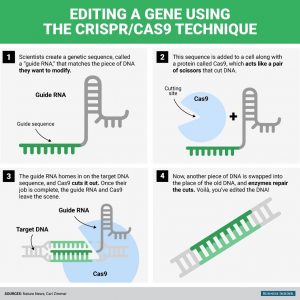According to recent experiments CRISPR/Cas9 technologies are proven to protect mice from cocaine -seeking behavior and cocaine overdose by releasing an enzyme called butyrylcholinestase (hBChE) which breaks down cocaine in the body. This successful use of the CRISPR technology is a huge advance for gene editing and opens up the possibility of gene editing technologies in treating drug addictions. However, does the success of this enzyme in mice mean it is ready to be implemented into humans?
What is CRISPR:
Clustered regularly-interspaced short palindromic repeats (CRISPR) (Source: YouTube) are segments of DNA which contain repeating segments of base sequences (the building blocks of DNA: ACTG). The protein associated with this technology, Cas9, is an enzyme that acts similarly to a pair of scissors, cutting specific strands of DNA. When implemented into a cell, CRISPR is able to target a particular gene with incredible accuracy, while Cas9 cuts the DNA, therefor changing the message and function of the DNA.
Although genome editing has been done before, CRISPR/Cas9 is more efficient, cheaper and faster. The best part? CRISPR was not made up in a laboratory, it actually comes from bacteria! (Source: YouTube). Bacteria use CRISPR/Cas9 in their immune system.

Figure 1. A walkthrough of how CRISPR/Cas9 work together to target and cut strands of DNA.
Source: Nature Biomedical Engineering
How does it work?
In a recent study CRISPR was used in order to edit skin epidermal stem cells (essentially the outside layer of a skin cell) of mice by adding the hBChE enzyme into the DNA, then transplanting the newly edited skin cells back into the mice. To compare the result of the edited genes and test lethal levels of cocaine, mice with and without the CRISPR edit were then exposed to different levels of cocaine. Below are the results of the mice five minutes after they were exposed to the drug, showing how the ones not exposed to the genes have a lower level of overdose.
Does this mean the technique would work if implemented in to humans as well? In order to test that, researches cultured human skin cells in a lab and then edited them with the CRISPR technology. The results were incredible! Not only did the altered gene express an increased amount of the hCBhE enzyme that helps break down cocaine, it also did not do any damage to the skin or show any detrimental side effects. This can address multiple concerns of drug abuse, by reducing development of cocaine-seeking behavior, preventing relapse of addiction and protecting from overdose.

Figure 2. Results of the enzyme implemented into mice skin cells showing success of enzyme on lowering levels of overdose Source: Nature Biomedical Engineering
What does this mean for the future? Will gene editing be the new “drug-rehab” for those with addictions or will it be too expensive for those struggling too afford? Hopefully it will not be too long until gene therapy with this enzyme will be the safe cost-effective option for drug addictions.
Li, Y.; Kong, Q.; Yue, J.; Gou, X.; Xu, M.; Wu, X. Nature Biomedical Engineering 2018.
To read the entire study click here
